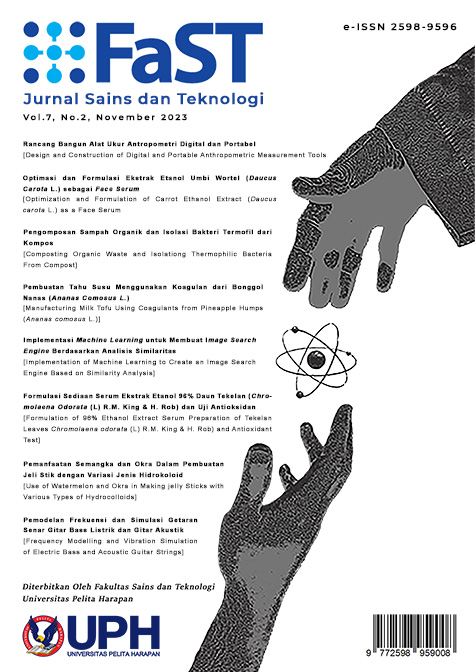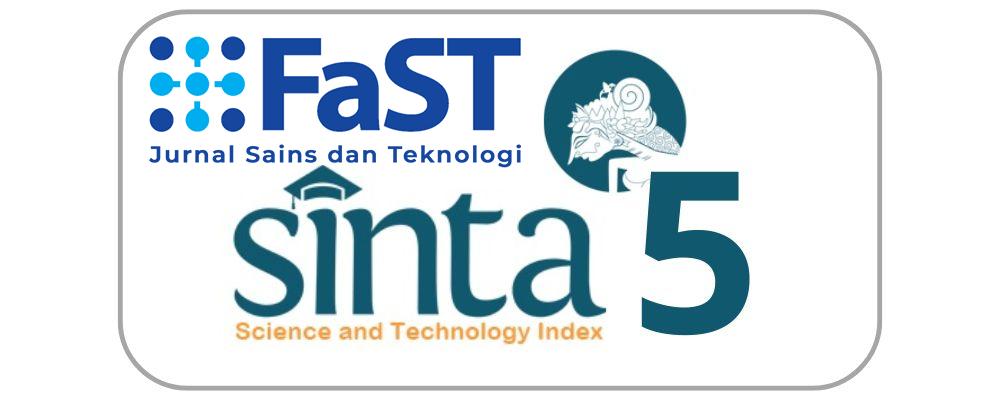OPTIMASI DAN FORMULASI EKSTRAK ETANOL UMBI WORTEL (Daucus carota L.) SEBAGAI FACE SERUM SEBAGAI FACE SERUM [OPTIMIZATION AND FORMULATION OF CARROT ETHANOL EXTRACT (Daucus carota L.) AS A FACE SERUM]
DOI:
https://doi.org/10.19166/jstfast.v7i2.7604Keywords:
antibacterial, face Serum, Staphylococcus aureus, carrotAbstract
Carrot bulbs are known to contain secondary metabolite compounds that can act as antibacterials due to their activity, which suppresses the synthesis of nucleic acid, cytoplasmic membrane function, and energy metabolism in bacteria. This research was carried out using laboratory experimental methods through the determination of the plant, production of simplicia, extraction by ethanol (96% as solvent) with the maceration method, phytochemical screening, antibacterial assay, optimization of the base formula, formulation of carrot extract, physical evaluation of the products, and hedonic testing. The yield of 96% ethanol extract of the carrot bulbs was 53.29%, and the water content of the extract was 16.14%. Furthermore, the antibacterial activity of the extract (500.000 ppm) against Staphylococcus aureus showed an inhibitory zone of 5.1 ± 3.42 mm. The carrot extract serum formulas F1, F2, and F3 meet the organoleptic and homogeneity criteria; however, the F2 formula does not meet the pH and viscosity criteria. Based on the hedonic statistical test, no significant difference was found in each formula; nevertheless, based on the average value of the respondents, it was known that the F1 formula had the highest preference.
Bahasa Indonesia Abstract:
Umbi wortel dapat berperan sebagai antibakteri karena mengandung senyawa metabolit sekunder yang dapat menekan sintesis asam nukleat, fungsi membran sitoplasma, dan metabolisme energi pada bakteri. Penelitian ini dilakukan dengan metode eksperimental laboratorium yang dilakukan dengan determinasi tumbuhan, pembuatan simplisia serta ekstraksi dengan pelarut etanol 96% dengan metode maserasi, skrining fitokimia, uji antibakteri ekstrak, optimasi basis sediaan, formulasi sediaan, evaluasi fisik sediaan, dan uji hedonik sediaan. Rendemen ekstrak etanol 96% umbi wortel yang diperoleh adalah sebesar 53,29% dan kadar air ekstrak adalah 16,14%. Aktivitas antibakteri dari ekstrak (500.000 ppm) terhadap Staphylococcus aureus menunjukan zona hambat sebesar 5,9 ± 0,49 mm. Sediaan serum ekstrak umbi wortel F1, F2, dan F3 memenuhi syarat organolepik dan homogenitas, namun sediaan F2 tidak memenuhi syarat pH dan viskositas sediaan. Berdasarkan uji statistik hedonik sediaan, tidak ditemukan perbedaan signifikan pada tiap sediaan, namun berdasarkan nilai rata-rata responden diketahui bahwa sedian F1 menjadi preferensi tertinggi.
References
Arifin, B., & Ibrahim, S. (2018). Struktur, bioaktivitas dan antioksidan flavonoid. Jurnal Zarah, 6(1), 21-29. https://doi.org/10.31629/zarah.v6i1.313
Ariyani, S. B., & Supriyatna, N. (2013). Perbandingan karbopol dan karboksimetil selulosa sebagai pengental pada pembuatan bioetanol gel. Biopropal Industri, 4(2), 59-64.
Aulifa, D. L., Caroline, M., Tristiyanti, D., & Budiman, A. (2020). Formulation of the serum gel containing green coffee bean (Coffea robusta L) extract as an antioxidant and tyrosinase enzyme inhibitor. Rasayan Journal of Chemistry, 13(4), 2346-2351. http://dx.doi.org/10.31788/RJC.2020.1345866
Boadi, N. O., Badu, M., Kortei, N. K., Saah, S. A., Annor, B., Mensah, M. B., Okyere, H., & Fiebor. A. (2021). Nutritional composition and antioxidant properties of three varieties of carrot (Daucus carota). Scientific African, 12, e00801. https://doi.org/10.1016/j.sciaf.2021.e00801
CLSI. (2020). CLSI M100-ED30: 2020 Performance standards for antimicrobial susceptibility testing (30th ed.). Clinical and Laboratory Standart Institute.
Depkes. (2000). Parameter standar umum ekstrak tumbuhan obat. Departemen Kesehatan Republik Indonesia.
Febri, R., & Rosa, Y. (2022). Aktivitas metabolit sekunder ekstrak etanol umbi wortel (Daucus carota L.) terhadap jamur Candida albicans. Jurnal Ilmiah Multi Sciences, 12(1), 34-40. https://doi.org/10.52395/jkjims.v12i01.341
Hasrawati, A., Hardianti, H., Qama, A., & Wais, M. (2020). Pengembangan ekstrak etanol limbah biji pepaya (Carica papaya L.) sebagai serum antijerawat. Jurnal Fitofarmaka Indonesia, 7(1), 1-8. https://doi.org/10.33096/jffi.v7i1.458
Khaira, Z., Monica, E., & Yoedistira, C. D. (2022). Formulasi dan uji mutu fisik sediaan serum mikroemulsi ekstrak biji melinjo (Gnteum gnemon L.). Sainsbertek Jurnal Ilmiah Sains & Teknologi, 3(1), 299-309. https://doi.org/10.33479/sb.v3i1.197
Putri, B. T., Chusniasih, D., & Nofita. (2022). Perbandingan aktivitas antibakteri ekstrak etanol dan aseton umbi wortel (Daucus carota L.) terhadap Streptococcus mutans secara in vitro. Jurnal Ilmu Kedokteran dan Kesehatan, 9(4), 1190-1197. https://doi.org/10.33024/jikk.v9i4.8600
Rasyadi, Y., Yenti, R., & Jasril, A. P. (2019). Formulasi dan uji stabilitas fisik sabun mandi cair ekstrak etanol buah kapulaga (Amomum compactum Sol. ex Maton). Pharmacy: Jurnal Farmasi Indonesia, 16(2), 188-198. https://doi.org/10.30595/pharmacy.v16i2.5675
Rowe, R. C., Sheskey, P. J., & Quinn, M. E. (2009). Handbook of pharmaceutical excipients (6th ed.). Pharmaceutical Press.
Rumanti, R. M., Fitri, K., Kumala, R., Leny, & Hafiz, I. (2022). Pembuatan krim anti aging dari ekstrak etanol daun pagoda (Clerodendrum paniculatum L.). Majalah Farmasetika, 7(4), 288-304. https://doi.org/10.24198/mfarmasetika.v7i4.38491
Septiyanti, M., Liana, L., Sutriningsih, Kumayanti, B., & Meliana, Y. (2019). Formulation and evaluation of serum from red, brown and green algae extract for anti-aging base material. In AIP Conference Proceedings. International Symposium on Applied Chemistry. https://doi.org/10.1063/1.5134642
Singh, R., Shushni, M. A. M., & Belkheir, A. (2015). Antibacterial and antioxidant activities of Mentha piperita L. Arabian Journal of Chemistry, 8(3), 322-328. https://doi.org/10.1016/j.arabjc.2011.01.019
Sirait, A. Y., Pelealu, N. C., & Yamlean, P. V. Y. (2016). Uji daya antibakteri ekstrak etanol umbi wortel (Daucus carota L.) terhadap Staphylococcus aureus dan Escherichia coli secara in vitro. Pharmacon Jurnal Ilmiah Farmasi, 5(4), 145-154. https://doi.org/10.35799/pha.5.2016.13985
Tsabitah, A. F., Zulkarnain, A. K., Wahyuningsih, M. S. H., & Nugrahaningsih, D. A. A. (2020). Optimasi carbomer, propilen glikol, dan trietanolamin dalam formulasi sediaan gel ekstrak etanol daun kembang bulan (Tithonia diversifolia). Majalah Farmaseutik, 16(2), 111-118. https://doi.org/10.22146/farmaseutik.v16i2.45666
Voight, R. (1994). Buku Pengantar Teknologi Farmasi (pp. 572-574). Universitas Gadjah Mada Press.
Wahyuningsih, S., Bachri, N., Awaluddin, N., & Andriani, I. (2021). Serum wajah fraksi etil asetat daun beluntas (Pluchea indica L.) sebagai antibakteri. Jurnal Katalisator, 6(2), 270-283. https://doi.org/10.22216/katalisator.v6i2.684
Downloads
Published
Issue
Section
License
“Authors who publish with this journal agree to the following terms:
1) Authors retain copyright and grant the journal right of first publication with the work simultaneously licensed under a Creative Commons Attribution License (CC-BY-SA 4.0) that allows others to share the work with an acknowledgement of the work's authorship and initial publication in this journal.
2) Authors are able to enter into separate, additional contractual arrangements for the non-exclusive distribution of the journal's published version of the work (e.g., post it to an institutional repository or publish it in a book), with an acknowledgement of its initial publication in this journal.
3) Authors are permitted and encouraged to post their work online (e.g., in institutional repositories or on their website). The final published PDF should be used and bibliographic details that credit the publication in this journal should be included.”





